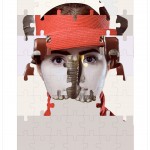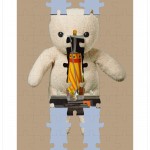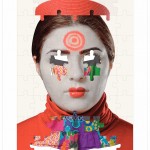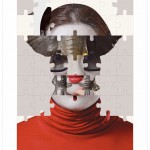Negar Farajiani Puzzles of Meanings
In Seattle at the M.I.A. gallery, we have the treat of an exhibition of work by Negar Farajani until November 16. Negar is from Tehran, Iran. I had the opportunity to talk with her about her art work and life in Iran. Negar is part of a group of young artists in many media who are based in Tehran. In addition to her own art, she also curates exhibitions and organizes projects with other artists.
I met Negar Farajani in the M.I.A. gallery, a sliver of a gallery in a downtown space run by the sophisticated Mariane Lenhardt, recently moved here from Paris, with roots in Somalia. We plunged right into a stimulating discussion about modernism in Africa. But that had to wait for another day to be completed as my main focus was to learn about Negar’s art in the gallery and life for artists in Iran.
Negar was born in Yazd, one of the oldest city’s in Iran. Yazd is in the center of Iran, a spectacular city in the midst of deserts (formerly an oasis), with historical architecture, crafts traditions, and Zoroastrian shrine. She went to art school there. Negar now lives in Tehran with her husband, who is a musician; he plays the “tar”, a predecessor of the guitar. He also composes music for films. They have a four year old son.
The exhibition in Seattle consists of intersecting works, based on the same format, the jigsaw puzzle. The artist cut the jigsaw pieces from dry mounted photographs of things in her life such as her son’s teddy bear, an ipod, a toy car or elephant, then reassembled the images by mixing and matching (all of the jigsaw puzzles are identical in their cuts).
The result is a provocative suggestion of the intersections of cultures and the complexity of life. Inserting some unidentifiable object into a teddy bear and calling it terminator is an idea that can be understood anywhere.
The most identifiable group consists of a reference to a trial: the accuser, the attorney, the witness, ( see above) and the executioner.
It was not clear if each layer had a specific reference or metaphor, but the overall effect is that reality and truth are elusive and sometimes frightening.
But Negar emphasized that people in Iran were leading ordinary lives. She was wearing a pink knit sweater and softer colored pink scarf hung around her neck. When I asked her, as no doubt everyone does, if she had to cover herself in black in Tehran, she said no, she could just toss this scarf over her head. So that suggests, at least for the privileged urban elite, the patrolling of women’s head coverings is in abeyance at the moment.
The artist explained to me that In Iran people often speak wordlessly with their eyes and indeed the eyes in these works were huge and expressive. But her main message was the idea of making a cultural bridge between cultures. She is hopeful that she can be a part of world peace.
This exhibition is just one fragment of Negar’s work, adapted for travel. On her website you can see the full range of her installations and projects, in many different media. One of her works is about an old spinning wool factory in Yazd now abandoned. Several artists created installations there, and Negar’s piece is a very large plastic beach ball ( “Made in China”) that is rolled around the space. Another work is called Tehran Monoxide, photographed many of her friends with children. The theme is the bad air in Tehran and how difficult it is for children to play outside, but what you see in the project is one young family after another, enjoying their small children. Such a simple set of images immediately gives us a much needed glimpse of real people living their lives.
It was delightful to meet her, and indeed, a small encounter like this with one person from Iran makes such a difference. I went home from meeting Negar and was immediately plunged into the Presidential Debate and its endless repetition about preventing Iran from getting a nuclear bomb and increasing sanctions. We have such a narrow view of the world in the US! Culture is indeed a great bridge and a peacemaker. We are all connected by creativity. That is what makes us human on a shared planet.
This entry was posted on October 25, 2012 and is filed under Contemporary Art, Uncategorized.












